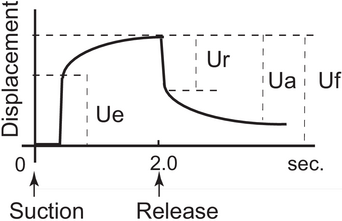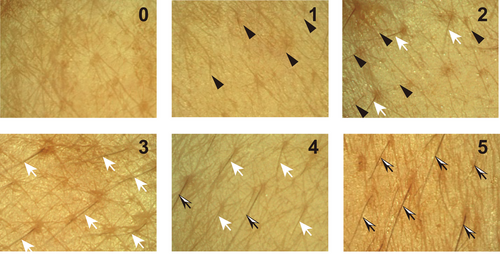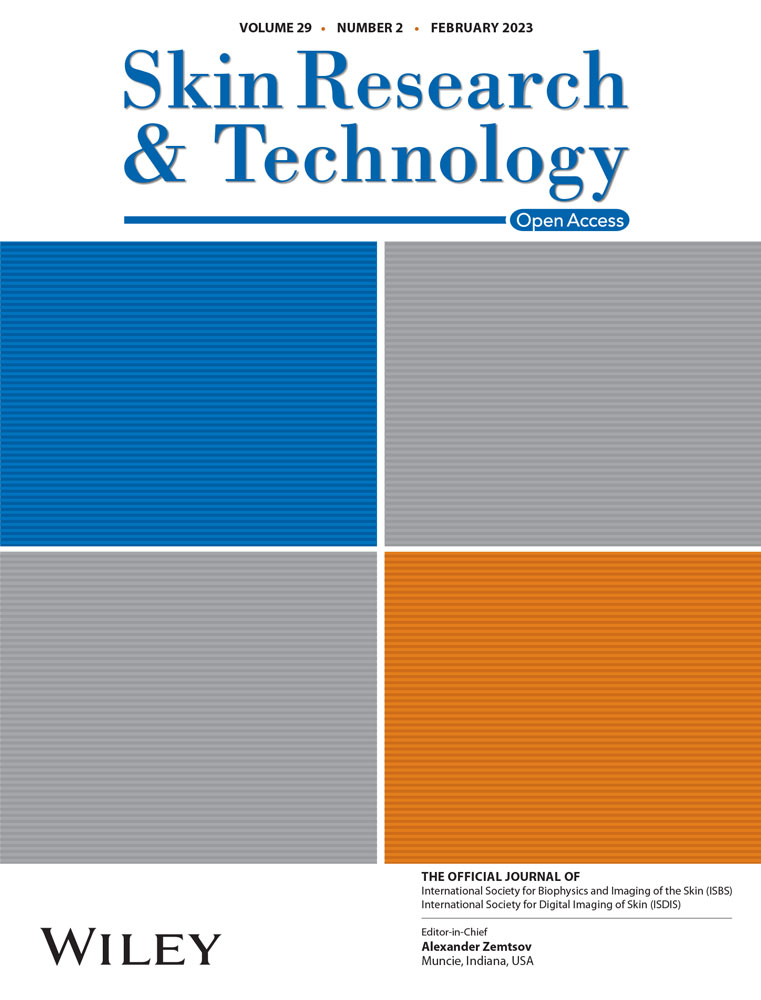Vellus hair condition is related to dermal elasticity and facial sagging severity
Abstract
Background
Sagging of facial skin is a critical factor associated with an aged appearance. However, the mechanism of sagging has not been fully elucidated. The facial skin contains vellus hair (fine hair), but the contribution of vellus hair to skin condition and facial aging has yet to be studied.
Aim
We aimed to clarify the influence of vellus hair on the physical properties and sagging severity of facial skin by establishing an evaluation system for vellus hair condition.
Method
Photographs were taken to assess the vellus hair condition in the cheek area in 30 middle-aged female volunteers. Skin elasticity was measured with a cutometer and sagging severity was evaluated by using previously established photograph-based grading criteria.
Results
Facial skin vellus hairs were divided into three types: fine, thick, and normal thickness. Based on this observation, we established a 6-grade photograph-based grading system based on the dominant type of vellus hair in the target area and used it to evaluate vellus hair condition at the cheek. We found that vellus hair condition is significantly positively related to skin elasticity parameters Ua/Uf (representing overall elasticity including creep and creep recovery), Ur/Ue (representing net elasticity without viscoelastic creep), and Ur/Uf (ratio of elastic recovery to total deformation). Further, vellus hair condition was significantly negatively correlated to sagging severity.
Conclusion
Our results suggest that vellus hair condition positively contributes to the skin's physical properties, and consequently deterioration of the vellus hair condition promotes an aged facial appearance.
1 INTRODUCTION
Sagging is a ptosis of the skin due to gravity and is a fundamental cause of aged facial appearance in both males and females.1 Thus, it is a matter of great aesthetic concern worldwide, resulting in a lower quality of life. We have shown that sagging is induced by the loss of skin elasticity with aging.2 However, the mechanism of this loss of skin elasticity has not been fully elucidated. Skin elasticity is mainly due to the dermal layer, which contains abundant extracellular matrix components, such as collagen, elastic fibers, and so on. Deterioration of these components as a result of intrinsic and extrinsic aging leads to impairment of the skin's physical properties.3
The skin contains a variety of appendages, such as sebaceous glands, sweat glands, and hair follicles.4 Vellus hair (fine hair) of the body is considered to contribute to mechanoreception.5 rather than thermopreservation in human beings.6 Since vellus hair is a critical drug delivery target,7 variations of follicular character have been studied, including in the facial area. Blume reported that the density of vellus hair is higher in facial skin than in body skin, obtaining values of 439 hairs/cm2 for the face (forehead) and 85 hairs/cm.2 for the body (back). Furthermore, 49% of the hairs on facial skin were growing, whereas 31.5% of the hairs on the body were growing. The growth rate varied from 0.03 mm/day on the forehead to 0.13 mm/day on the back.8 Although the facial area contains a high density of vellus hairs, the relationship between vellus hair and skin's physical properties has not been studied.
Hair follicles consist of epithelial and mesenchymal cells.9 Epithelial cells form the hair shaft and the inner and outer root sheath around the shaft. Mesenchymal cells are located at the base part of the hair follicle, called the dermal papilla (DP), and dermal sheath (DS) cells are located around the hair follicle as a thin layer. Hair follicle stem cells exist at the bulge region of the outer root sheath, and they migrate and differentiate into epithelial cells during wound healing.10
Since the vellus hair condition changes with aging,8 it could influence the condition of the dermal layer, as well as sagging. To clarify whether this is the case, we first established an evaluation system for vellus hair condition in facial skin, and then we used it to investigate the relationship of vellus hair condition with dermal elasticity and sagging severity.
2 METHODS
2.1 Subjects
Thirty healthy Japanese middle-aged female volunteers (nonsmokers and not taking medicines), aged 30s–50s, with body mass index <25 participated in this study. The study design was approved by Shiseido's ethics committee.
2.2 Study protocol
The volunteers washed their faces and were acclimated to the standard environmental conditions. The face was photographed at an angle of 45° from the front in a sitting position, and the sagging severity of the upper cheek area was evaluated on randomized photos by trained evaluators according to our established photograph-based grading criteria.11 Then, the skin surface at the center of the upper cheek was photographed under a video microscope, and the fine hair condition was evaluated from the image under randomized conditions.
2.3 Measurement of dermal elasticity
- Ue: immediate distension of the skin, representing elastic deformation
- Ur: immediate retraction of the skin, representing the elastic deformation recovery
- Uf: final distension at the end of the vacuum period, representing the total extensibility of the skin
- Ua: total deformation recovery

2.4 Statistical analysis
Correlations were evaluated with Spearman's correlation coefficient. A p-value of less than 0.05 was considered significant.
3 RESULTS
3.1 Establishment of noninvasive evaluation criteria for vellus hair condition
- 0: no vellus hair is observed
- 1: thin vellus hair is observed
- 2: normal thickness vellus hair is observed but thin vellus hair is dominant in the area
- 3: normal thickness vellus hair is dominant in the area
- 4: thick vellus hair is observed but normal thickness vellus hair is dominant in the area
- 5: thick vellus hair is dominant in the area

3.2 Vellus hair condition positively relates to skin elasticity
Using this vellus hair evaluation system, we next analyzed the relationship between vellus hair condition and skin physical properties in middle-aged female cheeks. Vellus hair condition is significantly positively related to elastic parameters, such as Ua/Uf (overall elasticity including creep and creep recovery), Ur/Ue (net elasticity without viscoelastic creep), and Ur/Uf (ratio of elastic recovery to total deformation) (Table 1). In other words, skin covered with thick vellus hair has a good physical condition, that is, high elasticity.
| Dermal elasticity parameters | |||
|---|---|---|---|
| Vellus hair condition | Ua/Uf | Ur/Ue | Ur/Uf |
| R | 0.583 | 0.577 | 0.593 |
| p-Value | <0.01 | <0.01 | <0.01 |
3.3 Vellus hair condition is positively correlated to sagging severity
Since we previously reported that skin elasticity is negatively related to sagging severity, and we found here that vellus hair condition is positively related to skin elasticity, we next investigated the relationship between vellus hair condition and sagging severity in the cheek skin of 30 female volunteers. We confirmed a significant relationship between skin elasticity and sagging severity (data not shown) and found that vellus hair condition is significantly negatively correlated to sagging severity at the cheek (Table 2). These results suggest that vellus hair condition is related to skin elasticity, a causal factor of sagging, and thus is in turn related to the sagging severity.
| Sagging severity | ||
|---|---|---|
| R | p-Value | |
| Vellus hair condition | −0.408 | <0.001 |
4 DISCUSSION
In this study, we first established a photograph-based 6-grade evaluation system of vellus hair condition. Then, by using it, we clarified that vellus hair condition is positively related to skin elasticity. Furthermore, vellus hair condition is negatively correlated to sagging severity.
To evaluate the vellus hair condition of the skin, we established a simple grading method with clear criteria, based on simply judging the dominant hair type in the target area. Although it might be useful to measure the diameter of vellus hairs on the images to assess the condition of vellus hair quantitatively, it would be impractical to measure the huge number of very fine vellus hairs, especially vellus hairs that we classified as grade 1 or 2. At present, it is not feasible to use an artificial intelligence deep learning system to detect vellus hairs in the images automatically, because the skin's microrelief pattern, which varies from person to person in the facial area, resembles vellus hair in photographs.13 Traditionally, skin surface biopsy using cyanoacrylate has been used to evaluate vellus hair,14 but this is invasive and cannot be applied repeatedly in the same area over a short time period. Therefore, our photograph-based grading system could be a useful tool for the rapid evaluation of vellus hair for research purposes, as well as in the clinic, or for consumer service.
Our results show that vellus hair condition is related to skin elasticity. This finding seems reasonable based on the contribution of hair follicles to skin physiology, although further study will be necessary to clarify the mechanism. Jahoda proposed that mesenchymal cells of DP and DS cells could promote fibroblasts in the dermal layer.15 Recently, Tao et al. showed that DS mesenchymal stem cells generate fibroblasts in the dermal layer by cell lineage analysis. Further, Aamar et al. showed that DP/DS cells migrate to the dermal layer at wound sites.16 Moreover, hair follicles have a growth cycle (hair cycle), consisting of a growth phase (anagen), a regression phase (catagen), and a resting phase (telogen).17 During the growth cycle, the size and lower part of the hair follicle change in the extracellular matrix (ECM) of the dermal layer, and ECM-degrading enzymes, such as matrix metalloproteinase 2 (MMP2) and MMP9, are secreted.18 Therefore, it could be possible that hair follicle influences the dermal layer condition at the cellular and ECM levels.
Since we have shown that vellus hair condition is related to skin elasticity, we can predict skin elasticity simply from photographs of the skin surface, instead of using measuring instruments and devices. This will be helpful not only for rapid assessment of the skin's physical condition but also for evaluation of a variety of aesthetic concerns, such as wrinkles.19 and loss of facial contour,11 as well as clinical issues, such as delay of wound healing and pressure ulcer.20 Indeed, sagging severity, which we reported to be correlated with skin elasticity,2 was also shown to be related to the vellus hair condition in this study.
Taken together, our results indicate that vellus hair positively contributes to skin elasticity, and thus deterioration of the vellus hair condition can induce sagging of the face. Therefore, vellus hair could be a critical marker of impaired skin condition and aged facial appearance, as well as a critical target for aesthetic concerns and clinical issues related to the skin's physical properties.
Open Research
DATA AVAILABILITY STATEMENT
Research data are not shared.




